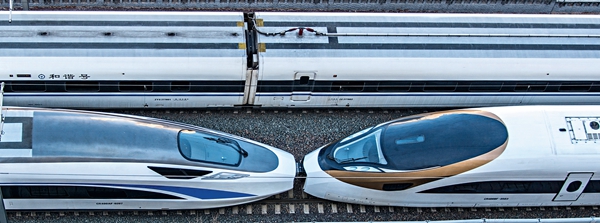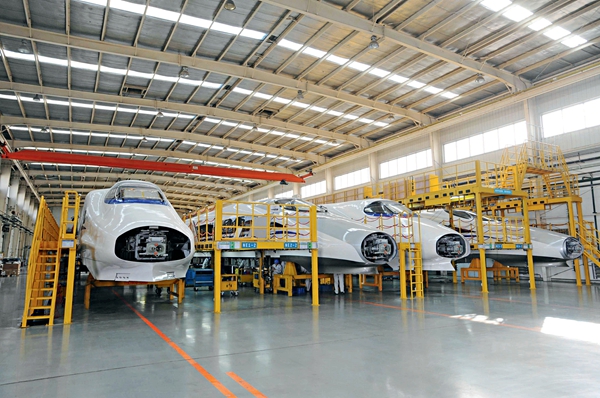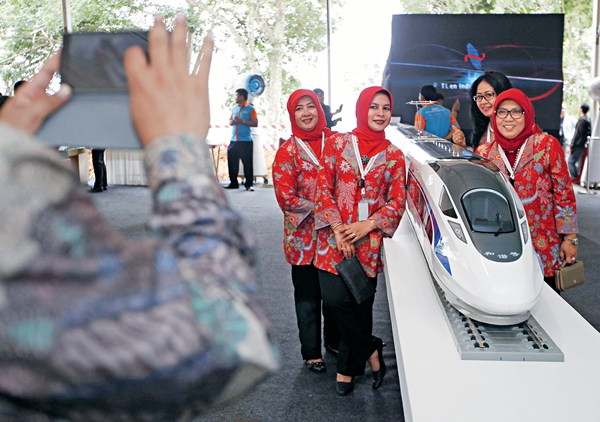China’s World-class High-speed Rail Network
By staff reporter DANG XIAOFEI
IT used to be the case that in order to buy a Boeing aircraft China needed to sell 800 million shirts and blouses. Now things have changed. The country’s manufacturing industry is becoming increasingly high-tech. A key example is China’s cutting-edge high-speed railway technologies. Reliable and cost-effective, they are a glowing achivement on the country’s high-end manufacturing resume.
Although a latecomer, China quickly moved to the forefront of high-speed railway technology within the space of nine years. You may wonder what the secret was to its quick success and what resulted from the radiation-effect it created.
Success from Innovation
On the Chinese mainland, a high-speed rail network stretches across the country. Lines track across plains, rivers, deserts, plateaus of permafrost or tropical forests – and plenty more are still to come. For most travelers, high-speed railway is no longer a thing of the future; instead, it has become a necessity.

In 2007, China launched its first self-made multiple unit (MU) train with a speed of 300 km per hour. In 2010, the Beijing-Shanghai high-speed railway managed to reach 486.1 km per hour, and in 2016, two “China-standard” EMU (electric multiple unit) trains, the Golden Phoenix and Dolphin Blue, ran past each other at a speed exceeding 420 km per hour, which means passengers on each train were travelling at 117 meters per second… These are the highlights of China’s high-speed railway history so far.
“Innovation is the key to our technological breakthroughs,” said Shang Jing, vice president and chief engineer of Zhuzhou CRRC Times Electric Co., Ltd. At present, China’s high-speed railway technology is among the most advanced in the world.
“China-standard” EMU trains, the latest generation of high-speed trains, signify that China has grasped the core technology in this field. Shang Jing explained, “‘China-standard’ EMU trains were developed independently by our country. Its core system is 100 percent developed by China.”
“In order to reduce noise, we have set up a special investigative research team. During the day when the trains are operational, our technicians analyze the data, and at night when the trains are off the tracks, they verify it. We have improved the software on the trains over 100 times.”
Through trial and error, the noise produced when the train starts is now limited to between 76 and 78 decibels, compared with the 80 decibels of their foreign competitors. “This small reduction is not to be sneezed at. Passengers now need not endure high-pitch noise when boarding the trains.” Shang Jing told us this was just one minor example of the innovations his team has achieved.
Through innovation, China has independently developed the networked control system (NCS) – the heart of high-speed rail – and IGBT chips. As a result, China now has a high-speed rail system, covering all areas – from engineering construction, high-speed EMU, train control, operation management, and traction power supply, to risk prevention and quality control.
By the end of 2016, the total length of China’s rail network had reached 120,000 km, of which high-speed tracks accounted for one sixth. The EMU trains have travelled over 3.8 billion km in total, and have carried 5 billion passengers. There are more than 4,200 EMU trains running on high-speed tracks, carrying 4.5 million passengers every single day.
A Hive of Industry along the Tracks
Chinese people’s “high-speed railway life” actually began in 2008 when the Beijing-Tianjin line first became operational. Serving as a platform upon which other industries are layered, China’s high-speed railways have integrated industries worth trillions of RMB, greatly multiplying their economic value.
According to Shang Jing, “A complete industry chain has formed in China’s high-speed rail industry, including locomotive manufacturing, key components and accessories production.”

The Zhuzhou CRRC Times Electric Co., Ltd. is situated in Zhuzhou, a city in Hunan Province, southern China. It is seen as the center of China’s railroad diplomacy. A number of rail-related industries have clustered here, forming a complete industrial chain ranging from R&D to manufacturing, after-sales service and logistics.
At present, there are over 320 enterprises providing rail transit equipment, among which 62 are enterprises above designated size. “This cluster of related enterprises will give China’s rail transit industry the edge it needs to compete in the international arena, while radiating to 30 other industries. Chinese companies will thus take a share in the global rail transit market worth € 190 billion,” said Liu Youmei, an academician of the Chinese Academy of Engineering and head of the expert’s commission at Zhuzhou CRRC Times Electric.
Undoubtedly, as high-speed railway develops, related industries such as iron and steel, new materials, infrastructure development and machine building also benefit. Shang Jing believes that the high-speed railway’s strict selection of suppliers forces companies to improve their quality, safety and cost. As a result, the whole manufacturing sector has progressed.
A good example of this radiation effect is an “EMU train town” in Qingdao, where CRRC Qingdao Sifang Co., Ltd., is located. Qingdao is a coastal city in East China where there are more than 100 suppliers of rail equipment. In the country as a whole there are more than 500 equipment suppliers, contributing to an annual output value of nearly RMB 100 billion.
This radiation effect of high-speed rail has even further-reaching implications. It also benefits regional economic development. Wang Lan, an official from China Academy of Railway Sciences, commented: “The building of high-speed railways will strengthen links between cities, aiding the quick flow of capital, technology and human resources within a region. As a result, the interaction between cities will be much more effective.”
More importantly, as China’s high-speed rail industry goes global, both the Chinese economy and foreign countries stand to benefit.
Going Global
The globalization of China’s high-speed rail industry serves to support the roll-out of the Belt and Road Initiative. In Asia alone, travel speeds of 300 km per hour will make most Asian cities reachable within 24 hours. In addition to logistics and cost advantages, there is also the conventional advantage of freight transportation.

Several multinational projects are underway, such as the Jakarta-Bandung line in Indonesia, the Moscow-Kazan line in Russia, and the Kuala Lumpur-Singapore line.
Take the Jakarta-Bandung (JB) line in Indonesia as a case-study. Construction started at the beginning of 2016. This line has 150 km of high-speed tracks, linking Indonesia’s capital to its fourth largest city. Its highest speed is designed to reach 350 km per hour and the line is expected to become operational in three years. The journey between the two cities will take just 40 minutes instead of the present three hours.
This line not only exports China’s industries, but also brings benefits to people along the Belt and Road routes and promotes the development of local industries such as the rail industry. Mr. Soemarno from Indonesia’s Ministry of State-owned Enterprises said that the JB line will create new economic growth zones along its tracks, and lay foundations for the building of a future Jakarta-Surabaya line.
The Mayor of Bandung added that Bandung is a service-oriented city reliant on commerce and trade, investment and tourism. The JB line will bring 10 times as many people as before, which will be a big boost to the city’s economy.
“At present, there’s no rail transit in Bandung, and the city’s annual growth rate is 8.8 percent,” he said. “I’m confident that this figure will surge to over 10 percent when the JB high-speed railway and light rail transit system become operational.” The JB high-speed railway is expected to drive the development of smelting, manufacturing and infrastructure construction in Indonesia, thus bringing more work opportunities and fuelling the upgrade of its industrial structure.
